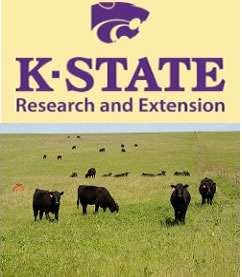K-State’s Jenny Ifft says choices, coverage are better than in years past
MANHATTAN, Kan. – The use of crop insurance by farmers is pretty common across the United States. Livestock insurance, not so much.
A Kansas State University agricultural economist believes, however, that recent improvements in risk management products for livestock producers by the USDA’s Risk Management Agency may make them worth a second look.
“We like to say the federal crop insurance program is the foundation for the federal farm safety net in the U.S., but there are a lot of products in the federal crop insurance program that can be used by livestock producers,” said Jenny Ifft, associate professor and agricultural policy specialist with K-State Research and Extension.
Livestock insurance programs have not been embraced like crop insurance has for several reasons, said Ifft, noting that in many cases 90% of eligible crops are covered by crop insurance, but the use of livestock insurance is much less common.
Livestock insurance products haven’t been as developed as long and historically, participation has been capped or limited by either the number of head or amount of dollars, and the cost sharing with the federal government has been lower, she said.
“The way I like to look at insurance is that farmers are always making decisions about the future and you try to make the best decisions you can with the best information you have,” Ifft said.
“Information on costs, prices, weather and what kind of production you expect – all of those things are uncertain and can be different in the future from what you expect today. The point of insurance is to get you closer to what you expect for cost, prices and production, so that you can make better decisions today.”
She outlined three primary livestock insurance choices.
1) Whole Farm Revenue Protection has been in existence since 2015. It’s not widely used in Kansas with only six farms covered in 2020 under such a policy. Public awareness and knowledge about this type of coverage is still limited. This type of coverage was mostly developed for the purpose of providing an insurance option for diversified farming operations. It covers everything that’s produced on the farm and can include up to $2 million of livestock revenue.
For those who have three to six major crops and livestock, five years of tax records and basic production records, WRFP may be worth considering, Ifft said. The tax records are used to set the guarantee.
2) Livestock Risk Protection is based on livestock futures prices and protects against drops in futures market prices. This product can be used to cover feeder cattle and cattle on feed in feedyards. Recent changes in this type of insurance may make it more attractive to producers than it has in the past, in that cost sharing from the federal government is now higher. Previously cost sharing was 25%-35% of premium cost but that’s now been expanded to 35%-55% of premium cost. Additionally, the number of head possible to cover has been increased from 6,000 previously to 12,000 currently per year. Producers can enroll in this coverage any time during the year.
3) Forage Production Risk is a product that has been catching on in Kansas and other states, Ifft said, particularly the Pasture, Rangeland and Forage choice. Almost 2 million acres of pasture are enrolled in this type of coverage in the state this year. That sounds like a lot, she added, unless you consider that more than 5 million acres each in corn and wheat are enrolled in crop insurance programs.
“It’s grown a lot but it’s still relatively new and relatively small,” Ifft said of this type of risk management. “This program effectively protects against drought risk. It’s based on rainfall in a producer’s area. In this case, there just needs to be less rainfall during a coverage period in a producer’s area than there has been historically.”
In addition to the programs administered by the Risk Management Agency, Ifft said the USDA’s Farm Service Agency also has programs that can help producers, particularly with weather or disaster events.
“In determining your options, it helps to know breakeven costs. We ag economists always recommend knowing your costs for a number of reasons and one of those reasons is so you can manage your price risk,” she said.
An Agriculture Today radio interview with Ifft on this topic is available online.
FOR PRINT PUBLICATIONS: Links used in this article
Risk Management Agency, www.rma.usda.gov/Policy-and-Procedure/Insurance-Plans/Livestock-Insurance-Plans
Farm Service Agency, www.fsa.usda.gov
Agriculture Today (interview with Jenny Ifft), https://agtodayksu.libsyn.com/risk-management-insurance-for-cattle-producersfsa-program-deadlines-ahead
K‑State Research and Extension is a short name for the Kansas State University Agricultural Experiment Station and Cooperative Extension Service, a program designed to generate and distribute useful knowledge for the well‑being of Kansans. Supported by county, state, federal and private funds, the program has county extension offices, experiment fields, area extension offices and regional research centers statewide. Its headquarters is on the K‑State campus in Manhattan. For more information, visit www.ksre.ksu.edu. K-State Research and Extension is an equal opportunity provider and employer.
For more information:
Jenny Ifft
Written by:
Mary Lou Peter





